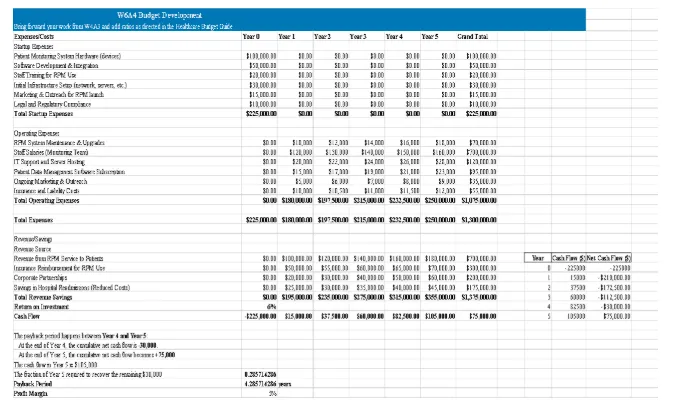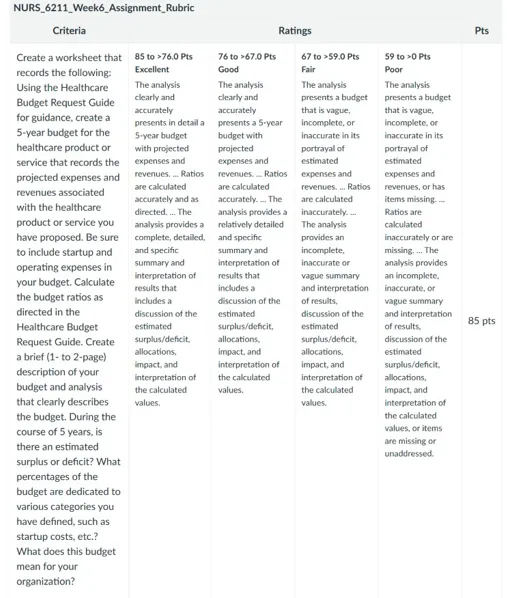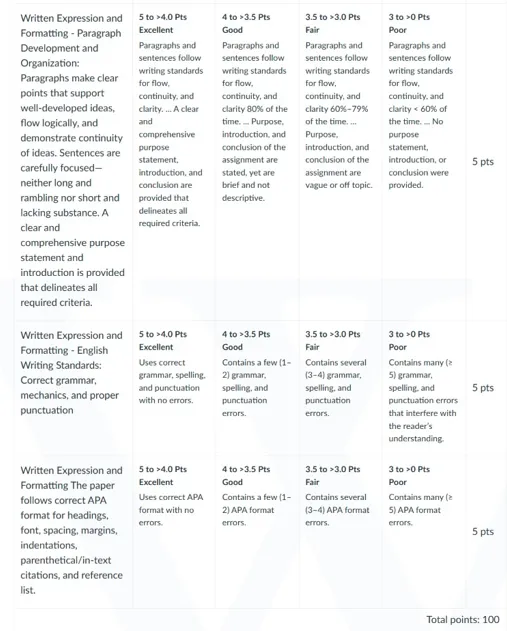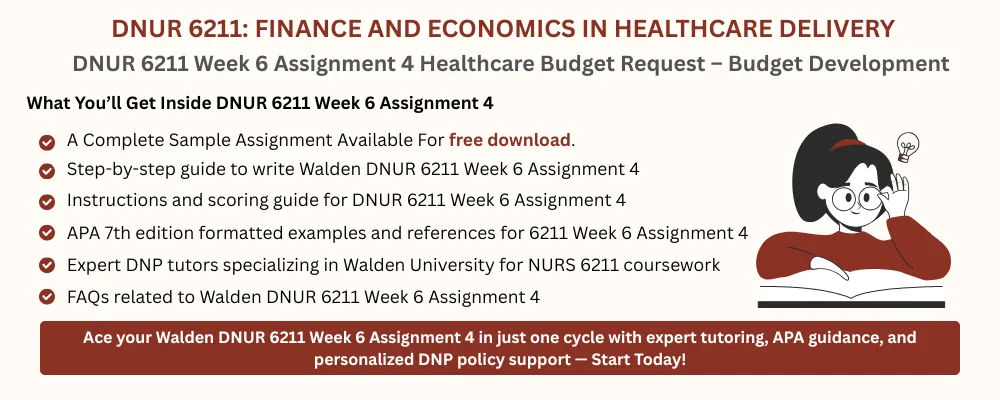DNUR 6211 Week 6 Assignment 4 FREE DOWNLOAD
DNUR 6211 Week 6 Assignment 4
Healthcare Budget Request – Budget Development
Student Name
Walden University
DNUR 6211: Finance and Economics in Healthcare Delivery
Professor Name
Date
W6A4 Healthcare Budget Request – Budget Development

Summary of Analysis and Interpretation of Results
The Remote Patient Monitoring (RPM) system at HealthWays is an innovative healthcare initiative designed to improve patient outcomes by allowing continuous health monitoring outside traditional clinical settings. This five-year budget estimates future revenue, identifies potential risks, and outlines the expenses of launching and operating the system to maintain financial sustainability.
Surplus or Deficit Over Five Years
The budget indicates a $225,000 deficit in Year 0 due to substantial startup expenditures. The deficit will eventually decline, though, as the RPM system generates revenue from patient services, insurance reimbursements corporate partnerships, and savings from fewer hospital readmissions. It is anticipated that the net cash flow will be -$30,000 by the end of Year 4. The system will produce positive cash flow in Year 5, with an estimated $75,000 surplus. Shortly after Year 4, the RPM system will start to recover its costs and turn a profit, guaranteeing long-term financial sustainability. The initial investment payback period is roughly 4.29 years.
Budget Allocation Across Categories
Resources are set aside in the budget for both startup and operational expenses. At $100,000 (44.44 percent of the overall startup costs), the Patient Monitoring System hardware is the largest expense in Year 0. Staff training costs $20,000 (8.89%), and software development and integration come in second with $50,000 (22.22%). Additional startup expenses include $15,000 for marketing and outreach (6.67%), $10,000 for legal and regulatory compliance (4.44%), and $30,000 for infrastructure setup (13.33%).
Ongoing operational expenses from Year 1 to Year 5 focus primarily on staffing and technology. The monitoring staff salaries, totaling $700,000 (65.12% of operating expenses), are the largest expense. RPM system maintenance and upgrades ($70,000 or 6.51%), server hosting and IT support ($120,000 or 11.16%), patient data management software subscriptions ($95,000 or 8.83%), ongoing marketing ($35,000 or 3.26%), and insurance and liability expenses ($55,000 or 5.11%) are additional operational costs. The significance of technology infrastructure and skilled personnel to the system’s success is reflected in these allocations.
Risks and Mitigation Strategies
Several risks could result in budget variances over the five years. Technology challenges, including malfunctioning devices or problems with software integration, may raise expenses. A contingency fund should be established, and regular system testing and maintenance should be carried out, to reduce this risk. Changes in healthcare laws or reimbursement policies may also have an impact on revenue, especially from insurance reimbursements (Rakers et al., 2023). To mitigate this risk, keeping up with regulatory changes and consulting legal experts is suggested. Furthermore, variations in the demand for RPM services may affect revenue. Stabilizing revenue streams can be achieved through corporate partnerships and ongoing marketing campaigns. Lastly, issues with staffing, like recruitment difficulties or employee turnover, may raise labor expenses. Reducing this risk can be achieved by prioritizing retention and providing competitive pay.
Implications for HealthWays
This budget marks a significant investment in HealthWays’ future. Value-based care will be supported, hospital readmissions will be decreased, and patient care will be enhanced by the RPM system (Charkviani et al., 2023). Financial sustainability is indicated by the project’s expected positive cash flow by Year 5, notwithstanding the initial deficit. If the program is implemented successfully, it will improve patient satisfaction, operational efficiency, and HealthWays’ standing as a pioneer in healthcare innovation. It also fits with the expanding trend of digital health.
Struggling with DNUR 6211 Week 4 Assignment 3? Click here to access expert solutions and downloadable Healthcare Budget templates now!
Instructions To Write DNUR 6211 Week 6 Assignment 4
Need instructions for this assessment? Contact us now and get expert guidance right away!
Instructions File For 6211 Week 6 Assignment 4
W6A4 HEALTHCARE BUDGET REQUEST – BUDGET DEVELOPMENT
How do you make difficult decisions? Do you carefully consider the repercussions of each choice? Perhaps you discuss possible outcomes with others. Maybe you rely on tools for help, even if the tool is a coin that can help you reach a conclusion with a simple flip.
Healthcare organizations generally don’t have an unlimited stack of coins, neither for flipping nor for spending. Therefore, they must be strategic in how they spend the resources they do have.
Budgeting is a process by which they can decide which projects or purchases are worth the cost involved. They must decide if they should expand their operations, invest in new equipment or services, or pursue other potential opportunities to bring in additional profits.
In this assignment, you examine how budgets are developed. After developing a sample budget for a project, you also examine how ratios can be used to analyze the budget and provide information for decision-making.
RESOURCES
Be sure to review the Learning Resources before completing this activity. Click the weekly resources link to access the resources.
WEEKLY RESOURCES
TO PREPARE
Reflect on the expenses and revenues you considered in the Week 4 Assignment.
Consider any other expenses that you have yet to account for in the development, launch, and implementation of the healthcare product or service you have proposed.
Consult with your internal finance counselor to help identify and estimate any hidden expenses that may not be obvious.
THE ASSIGNMENT: BUDGET DEVELOPMENT
Develop and analyze a budget for your proposed healthcare product or service. To do this, complete the following:
Part 1: Develop the Budget Worksheet:
Open your Excel Assignment Workbook and navigate to the “W6A4 Budget Development” worksheet.
Using the Healthcare Budget Request Guide for guidance, create a 5-year budget for the healthcare product or service that records the projected expenses and revenues associated with the healthcare product or service you have proposed. Be sure to include startup and operating expenses in your budget. You may bring forward the work from the W4A3 Estimated Expenses assignment and add to it.
Calculate the budget ratios as directed in the Healthcare Budget Request Guide.
NOTE: You will copy your worksheet and analysis onto the Healthcare Budget Request Template (Word document) for submission. You will need to submit both the Healthcare Budget Request (a Word Document) and an Excel Spreadsheet for your Assignment submission. Please be sure only to submit your Assignment once you have uploaded these two components of your W6A4 Assignment.
Part 2: Summary of Analysis and Interpretation of Results:
Create a brief (1- to 2-page) description of your budget and analysis that clearly describes the budget. Be sure to address the following:
During the course of 5 years, is there an estimated surplus or deficit?
What percentages of the budget are dedicated to various categories you have defined, such as startup costs, etc.?
What does this budget mean for your organization?
Place your analysis on the Healthcare Budget Request Template under the section titled W6A4 Projected Budget (Five Year).
BY DAY 7 OF WEEK 6
Submit your Assignment.
SUBMISSION INFORMATION
Before submitting your final assignment, you can check your draft for authenticity. To check your draft, access
the Turnitin Drafts from the Start Here area.
To submit your completed assignment, save your Assignment as WK6Assgn_LastName_Firstinitial
Then, click on Start Assignment near the top of the page.
Next, click on Upload File and select Submit Assignment for review.
DNUR 6211 Week 6 Assignment 4 Rubrics


References For DNUR 6211 Week 6 Assignment 4
Charkviani, M., Simonetto, D. A., Ahrens, D. J., Amundson, R. H., Bell, S. J., Busch, J. J., Caine, N. A., Cleveland, E. J., Coelho-Prabhu, N., Barreto, E. F., Daniels, C. E., DeZutter, M. A., Ebbert, J. O., Kattah, A. G., Kohler, C. M., Leuenberger, A. M., Pahl, D. F., Reinschmidt, K. J., & Philpot, L. M. (2023). Conceptualization of remote patient monitoring program for patients with complex medical illness on hospital dismissal. Mayo Clinic Proceedings: Digital Health, 1(4), 586–595. https://doi.org/10.1016/j.mcpdig.2023.09.005
Rakers, M. M., van Os, H. J. A., Recourt, K., Mosis, G., Chavannes, N. H., & Struijs, J. N. (2023). Perceived barriers and facilitators of structural reimbursement for remote patient monitoring, an exploratory qualitative study. Health Policy and Technology, 12(1). https://doi.org/10.1016/j.hlpt.2022.100718
Best Professors To Choose From For DNUR 6211 Class
- Dr. Mary Bemker Houghtaling
- Dr. Christine Frazer
- Dr. Deanna Johnson
- Dr. Judi Kuric
- Dr. Diane Whitehead
(FAQs) related to DNUR 6211 Week 6 Assignment 4
Question 1: Where can I download a free sample for DNUR 6211 Week 6 Assignment 4?
Answer 1: Download a free DNUR 6211 Week 6 Assignment 4 sample from Tutors Academy.
Question 2: Where can I find the rubrics and instruction file for DNUR 6211 Week 6 Assignment 4?
Answer 2: Access the rubrics and instructions for DNUR 6211 Week 6 Assignment 4 on Tutors Academy.
Question 3: What is DNUR 6211 Week 6 Assignment 4 about?
Answer 3: It focuses on healthcare financial analysis and budget improvement strategies.
Do you need a tutor to help with this paper for you with in 24 hours.
- 0% Plagiarised
- 0% AI
- Distinguish grades guarantee
- 24 hour delivery

